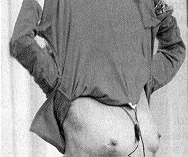TV
Centenary Boobs
Dercy Gonçalves, 89, shows it all.
 Eternally
Eternally
irreverent bad girl of vaudeville turned TV star and cultural icon Dercy
Gonçalves never stops shocking the bourgeoisie. At age 89, she
has again made headlines by doing a striptease on TV where she once again showed her boobies. She did this five years ago in Rio, during Carnaval’s Escolas de Sambas’ pageant. This time the topless show was performed during Globo TV’s comedy program, Sai Debaixo (Stand Clear).
 The
The
scene was taped and provoked a stir even before it aired. Some thought
Globo would have second thoughts and skip the bare breasts show. They didn’t.
Carnaval singer Emilinha Borba, from the same generation as Dercy,
commented: “You can’t do something like this on TV. They should have
cut the part where she exaggerated, showing her breasts and raising her
legs. I didn’t know if I should laugh or cry when I saw it all.”
Guerrilla
Rectifying justice
The Brazilian military didn’t like the decision. Some of them, in anonymous
comments, called it a “historical toad,” but apparently they
didn’t have any other choice but to swallow the Justice Ministry’s decision
that guerrillas Carlos Marighella and Carlos Lamarca were
murdered by the military dictatorship in a situation where had no way of
defending themselves. Until now, the official version was that Marighella,
leader of ALN (National Liberating Action) and former Army captain Lamarca,
the leader of VPR (Revolutionary Popular Vanguard), had been killed while
resisting arrest. Lamarca was killed in 1971 in Bahia and Marighela in
1969 in São Paulo.
Now the families of both will receive a state pension. After the decision
by the Justice Ministry’s Special Commission on Political Dead and Disappeared
People, retired deputy-captain Jair Bolsonaro, probably expressing
the feelings of some of his colleagues in the military, commented: “Our
mistake was not having eliminated all the traitors, including President
Fernando Henrique Cardoso.”
People
Double score
Deciding he didn’t want any more children, Brazilian Sports Minister
Édson Arantes do Nascimento, 55, better known as Pelé,
had a vasectomy in 1979. But then he married Assíria Seixas Lemos,
14 years his junior, who wanted more children. A surgery to reverse the
vasectomy was unsuccessful and the couple resorted to in-vitro fertilization.
The results were Celeste (the name of Pelé’s mother) and
Joshua, born after only 30 weeks of gestation on September 28. The
minister was watching a soccer game when the news came that Assíria
was ready to give birth. After the scare and the good news, he commented,
“That was my life’s biggest emotion. Bigger than the day I reached
1,000 goals.”
Hasty merger
Universo Online (UOL) (http://www.uol.com.br)
and Brazil on Line (BOL) (http://www.bol.com.br),
the two competing Brazilian online services inspired by America on Line
(AOL), have merged after only six months of operation. Ironically, both
services started just hours apart, with each delivering half-baked products
so they could claim primacy on line. UOL is part of Empresa Folha da Manhã,
the owner of Folha de São Paulo, the biggest Brazilian daily
with 1 million-plus copies a day. BOL belongs to Grupo Abril, the largest
publisher of magazines in the country. The new service will use the UOL
moniker and will have 260,000 available pages. Echoing Humphrey Bogart
in Casablanca, Abril’s President Roberto Civita said: “This
is just the beginning of a long friendship.”
A little less poor
Even though there was only slight improvement, and the country is still
very far from the First World, the latest census figures in Brazil show
a nation with an improved distribution of wealth. IBGE’s (Instituto Brasileiro
de Geografia e Estatística — Brazilian Institute of Geography and
Statistics) 1995 sample census shows that while in 1993 the richest 10
percent claimed 49 percent of the salaries, this has dropped to 47.1 percent.
The average monthly salary of the poorest workers has increased from $23
in 1993 to $42 in 1995. And the number of TV sets in Brazilian homes has
grown from 75.8 percent in 1993 to 81 percent in 1995.
CNN clone
Inspired by American Cable News Network (CNN) and using the motto “real
life in real time,” Globo TV has launched its Globo News in Brazil,
a 24-hour news service for the 1 million subscribers of the satellite TV
services Net and Multicanal. Globo News promises to be more dynamic and
less repetitive than CNN. Globo News stars such as New York-based Paulo
Francis, political commentator Alexandre Garcia, and news anchor
Lilian Witte Fibbe will have their own programs on the new channel.
To present the news, Globo is counting on seven fresh faces, four men and
three women, most in their 20s.
Brazilian Nobel
He who thinks Brazil never won a Nobel prize doesn’t know the story
of Peter Medawar, who received the Nobel prize in Medicine in 1960.
Medawar was born in Petrópolis (state of Rio de Janeiro) in 1915
and left the country at age 14 to finish high school in the United Kingdom.
According to Maurice Joseph Kassab, 85, Medawar’s cousin, the scientist
lost his Brazilian citizenship because he refused to be drafted in the
military. The Nobel prizewinner died in England in 1987. Queen Elizabeth
made him Sir in 1965.
Going nuclear
President Fernando Henrique Cardoso wants to become the Atomic
President. No President since general Ernesto Geisel has dedicated
so much attention and money to the nuclear program. Cardoso would like
the military to accelerate the construction of the Brazilian nuclear submarine,
has restarted work at Angra 2 — a nuclear plant, and included the building
of a new plant (Angra 3) in the strategic planning of Eletrobrás,
the state company that has the electricity monopoly in the country. The
President has created a Center for Nuclear Sciences in Pernambuco and has
also committed to investing $20 million to produce uranium powder and uranium
tablets in Resende, state of Rio.
In Memoriam
Rock is crying
He could have continued taking the cocktail of drugs that would have
prolonged his life, but Renato Russo, the leader of Legião
Urbana (eight records, more than 5 million copies), the most popular Brazilian
rock band wanted to go. After fighting AIDS for six years, Russo, 36, left
the beard grow long, stopped eating and refused to see his friends. Reduced
to a shadow of himself at a mere 99 lb was unrecognizable just before dying
on October 11. Lately, his mantra had been, “Mom, I’m not from here.”
Until the end he refused to let his fans know about his disease. But
in “A Via Láctea” (Milky Way), the first cut on his latest
CD, A Tempestade (The Storm), he talked about his physical discomfort:
“Eu nem sei porque me sinto assim/Vem de repente, um anjo triste perto
de mim/E essa febre que não passa.” (“I don’t even know
why I’m feeling like that/Suddenly a sad angel comes close to me/And this
fever that doesn’t go away”). Russo had made public that he was gay.
Very few people knew however that his great love was American Robert
Scott whom he met in 1990 in a New York gay bar. The break-up after
two years of romance was very painful for the artist.
Geração Coca-Cola
Renato Russo
Quando nascemos fomos programados
A receber o que vocês
Nos empurraram com os enlatados
Dos USA de nove às seis
Desde pequenos nós comemos lixo
Comercial, industrial
Mas agora chegou nossa vez
Vamos cuspir de volta o lixo
Em cima de vocês
Somos os filhos da revolução
Somos burgueses sem religião
Somos o futuro da nação
Geração Coca-Cola/Geração Coca-Cola
Depois de 20 anos na escola
Não é difícil aprender
When we were born we were programmed
To receive what you
Shoved on us with the TV shows
from the USA, from 9 to 6
Since childhood we’ve been eating trash
Commercial, industrial trash
But now our time has come
We are gonna spit back the trash
All over you
We are the sons of the revolution
We are bourgeois without religion
We are the future of the nation
Coca-Cola Generation / Coca-Cola Generation
After 20 years in school
It’s not hard to learn
Art
Only the best
Picasso, Goya, Paul Klee, Andy Warhol,
and Edvard Munch (artist of The Scream) are all in São
Paulo until December 8, sharing space with 1,500 works of art by 135 other
artists.. To make this the biggest and best Bienal ever, the organizers
of the arts festival — which has been held at the Parque Ibirapuera in
São Paulo since 1951 — have spared no expense. The $12 million
price tag makes the XXIII Bienal the world’s costliest contemporary expo,
surpassing 1992’s German exposition Documenta in Kassel, which cost $10
million.
The theme this time around is “The Dematerialization of the Work
of Art at the End of the Millennium,” and the Bienal has new rules.
Each country invited to the show could choose only one representative.
All 34 foreign artists, plus eight Brazilians, were grouped at Universalis,
with a whole floor dedicated to them. There you can find names like Panamarenko,
Enzo Cucchi, Hernandez-Díez, Braco Dimitrijevic,
Luciano Fabro, Tom Friedman, Maria Tereza Hincapié,
Ben Jakober, Ilya Kabakov, Anish Kapoor, Cai Guo
Qiang, Yukinori Yanagi. Panamarenko, for example, is presenting
his dreamlike metal submarine sculpture.
According to some critics, the star of the exhibit is French-American
Louise Bourgeois, 85, who lives in the U.S. and only recently started
to have her work displayed in big international shows. Two of her best-known
works are in the Bienal: The Arch of Hysteria, a sculpture that
was also shown at Veneza’s Bienal in 1993, and the big spider, which represents
the mother of the artist. From Picasso there are a sculpture, several drawings,
and two dozen paintings. Munch’s The Scream is displayed, along
with 36 other paintings by the Norwegian artist. There are also 60 works
by the Swiss artist Klee and 46 by the American Warhol, including his portraits
of Mao Tse-Tung and Marilyn Monroe.
Ads
Sinful Innocence
Barely covered Ana Lara Resende

Cousin of late celebrated writer Otto Lara Resende, model Ana
Lara Resende has become a top cover girl in Japan. The Japanese love
her innocent kind of sensuality and placid beauty. Even though she has
already posed for Brazilian Playboy, provoking oohs and aahs from those
who saw every concavity of her anatomy, Ana Lara is still very shy at heart.
The Mineira (from Minas Gerais state) from São João
Del Rey only reluctantly posed for an ad campaign in which she wears only
a transparent blouse over her bare breasts. Btu when she saw the results
of lingerie manufacturer DuLoren’s pictures for its chemisette frisson,
she put aside her reservations and embarked satisfied to Paris for a fashion
show and a reunion with her boyfriend.



